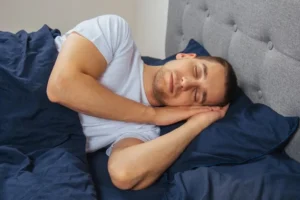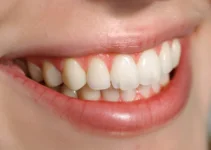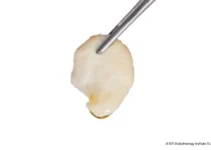Sleep apnoea is a significant medical condition where breathing stops and starts during sleep, often leading to disrupted sleep patterns and various health complications. Beyond its well-known impacts on cardiovascular health and fatigue, sleep apnoea can also affect oral health. In people with this condition, the increased efforts to breathe can lead to mouth breathing, which may in turn cause dry mouth. A lack of saliva often exacerbates conditions like tooth decay and gum disease. Additionally, the strain and stress placed on the jaw and facial muscles can potentially lead to disorders such as TMJ (temporomandibular joint disorder). Understanding the interplay between sleep apnoea and oral health is crucial for comprehensive patient care.
What is Sleep Apnoea?
Sleep apnea, medically known as Obstructive Sleep Apnea/Hypopnea Syndrome (OSAHS), is a common yet serious disorder characterized by repeated pauses in breathing during sleep. These pauses, called apneas, can last anywhere from a few seconds to a minute and may occur multiple times per hour. The most prevalent form of sleep apnea is OSAHS, where the airway becomes blocked or collapses, leading to interrupted breathing.
Recent studies have shown a direct relationship between bruxism and OSAHS, as well as between tooth wear and OSAHS. This makes dental professionals key players in identifying and managing this condition. Early detection and intervention are critical to preventing further complications related to sleep apnea, such as cardiovascular disease and daytime fatigue. Dentists, with their expertise in oral health, are in a unique position to recognize and treat mild to moderate cases of OSAHS.
The use of specialized intraoral devices, such as the APNiA Intraoral Device, allows dentists to manage OSAHS effectively. These devices are designed to prevent the retraction of the mandible and limit lateral movements, ultimately freeing the larynx and reducing snoring. By enhancing airflow during sleep, patients experience fewer disruptions, contributing to overall better health and quality of life.
Symptoms and Diagnosis
Identifying sleep apnea can be challenging, as many symptoms occur during sleep. Common signs and symptoms include loud snoring, episodes of breathing cessation observed by another person, abrupt awakenings accompanied by gasping or choking, dry mouth or sore throat upon waking, and excessive daytime sleepiness. Other symptoms may include morning headaches, difficulty concentrating, mood changes such as irritability or depression, and high blood pressure.
To diagnose sleep apnea, a comprehensive evaluation is necessary. This typically begins with a detailed medical and sleep history. Patients may be asked about their sleep patterns, snoring, and daytime fatigue. There are several diagnostic tools available, including:
- Polysomnography: This overnight sleep study is considered the gold standard for diagnosing sleep apnea. It monitors brain activity, eye movements, heart rate, blood pressure, blood oxygen levels, and breathing patterns.
- Home Sleep Apnea Testing (HSAT): This is a more convenient and cost-effective option for diagnosing OSAHS. It involves using portable monitoring devices that the patient wears at home to record similar parameters as polysomnography.
A dentist specializing in sleep disorders can also play a crucial role in the initial diagnosis. By examining signs of tooth wear, bruxism, and oral anatomy, as well as discussing symptoms with the patient, they can identify those who may benefit from further sleep studies and potential treatment with intraoral devices.
For further reading on related topics, check out our other articles that delve into the latest advancements in dental sleep medicine, the role of bruxism in OSAHS, and effective strategies for managing sleep apnea.
How Sleep Apnoea Affects Oral Health
Sleep apnoea is a significant medical condition characterized by the repeated interruption of breathing during sleep. It is divided into two main types: obstructive sleep apnoea (OSA) and central sleep apnoea (CSA). Both forms can have a profound impact not only on an individual’s overall health but also on their oral health. Studies have shown that there is a direct relationship between bruxism and OSAHS and between tooth wear and SAHS, highlighting the crucial role of dentists in identifying and managing these conditions.
For many patients, the dentist is the first healthcare provider to notice signs indicative of sleep apnoea. These signs may include tooth wear from bruxism, dry mouth, and gum disease. Understanding how sleep apnoea impacts oral health can help dentists provide better care and potentially identify patients at risk of this serious condition.
Dry Mouth and Cavities
One of the common oral health issues associated with sleep apnoea is dry mouth, also known as xerostomia. This condition arises because individuals with sleep apnoea often breathe through their mouths due to partial or complete blockage of the nasal airway. Mouth breathing can significantly reduce the production of saliva, which is essential for maintaining oral health.
Saliva plays a crucial role in neutralizing acids produced by bacteria, washing away food particles, and providing disease-fighting substances throughout the mouth. Without adequate saliva, the risk of developing cavities increases. Patients with sleep apnoea frequently present with multiple cavities that require ongoing dental intervention.
- Reduced saliva flow can lead to increased bacterial growth.
- Acids produced by bacteria are not effectively neutralized.
- Food particles are not adequately washed away.
Gum Disease and Other Issues
Another significant oral health issue linked to sleep apnoea is gum disease or periodontal disease. Chronic dry mouth and the resultant increase in oral bacteria can lead to inflammation of the gums, known as gingivitis. If untreated, gingivitis can progress to periodontal disease, affecting the bone and connective tissue that support the teeth.
Individuals with sleep apnoea are also at risk of experiencing other oral health problems such as temporomandibular joint disorders (TMJ) due to bruxism. Bruxism, the grinding or clenching of teeth, is more common in individuals with sleep apnoea and can lead to tooth wear, jaw pain, and headaches. Moreover, the use of continuous positive airway pressure (CPAP) machines, a common treatment for sleep apnoea, can also affect oral health. CPAP devices can cause or exacerbate dry mouth and gum irritation, making oral hygiene practices even more critical for these patients.
Given the multifaceted impact of sleep apnoea on oral health, it is essential for dentists to be vigilant in recognizing the signs and to collaborate with other healthcare providers to ensure comprehensive care for patients. For more in-depth information on related topics, be sure to explore our other articles.
Treatment Options for Sleep Apnoea
Treating sleep apnoea effectively requires understanding the underlying condition and its severity. The primary goal in treatment is to ensure that the airway remains open during sleep, thus improving breathing and sleep quality. Various treatment options are available, including lifestyle changes, surgical interventions, and mechanical aids. This article will focus on two main treatment modalities: oral appliances and Continuous Positive Airway Pressure (CPAP) machines.
Both oral appliances and CPAP machines have proven to be effective in managing sleep apnoea, particularly in mild to moderate cases. The choice between the two depends on several factors, including the severity of the condition, patient preference, and specific anatomical considerations. Recent studies show that oral appliances can often be just as effective as CPAP machines for certain patients, providing a viable alternative for those who have difficulty complying with CPAP therapy.
Oral Appliances
Oral appliances are custom-fitted devices worn in the mouth during sleep. They work by repositioning the lower jaw and tongue to keep the airway open. This treatment option is particularly beneficial for patients with mild to moderate Obstructive Sleep Apnoea-Hypopnoea Syndrome (OSAHS). Dentists play a crucial role in the fitting and adjustment of these devices, ensuring optimal comfort and effectiveness.
There are several types of oral appliances available, including mandibular advancement devices (MADs) and tongue-retaining devices (TRDs). Each has its specific indications and mechanisms of action:
- Mandibular Advancement Devices (MADs): These devices hold the lower jaw in a forward position, preventing airway collapse.
- Tongue-Retaining Devices (TRDs): These devices use a suction mechanism to hold the tongue in place, preventing it from blocking the airway.
Studies have shown that oral appliances are effective in reducing snoring and improving sleep quality in patients with mild to moderate OSAHS. They are often preferred by patients due to their ease of use and portability compared to CPAP machines.3,4
CPAP Machines
Continuous Positive Airway Pressure (CPAP) machines are a well-established treatment for sleep apnoea, particularly in patients with moderate to severe OSAHS. The CPAP machine delivers a steady stream of pressurized air through a mask, keeping the airway open and preventing apnoea events during sleep.
Despite their effectiveness, CPAP machines are often associated with several challenges, including discomfort, dryness of the nasal passages, and a sense of claustrophobia. However, for patients who can tolerate the device, CPAP machines offer significant improvements in sleep quality and overall health outcomes.
Recent advancements in CPAP technology have aimed to enhance patient comfort and compliance. Modern CPAP devices are quieter, more compact, and come with features such as heated humidifiers and pressure relief technologies. These advancements have helped increase patient adherence to therapy, making CPAP a viable long-term treatment option. Ultimately, the choice between oral appliances and CPAP machines depends on individual patient needs and preferences. Dentists and sleep specialists often work together to determine the most suitable treatment option, ensuring optimal outcomes and improved quality of life for patients with sleep apnoea.
If you found this information useful, make sure to check out our other articles on sleep apnoea and dental health to stay informed about the latest advancements and treatment options.
Frequently Asked Questions about Sleep Apnoea and Oral Health
Learn more about how sleep apnoea is connected to your oral health and what dentists can do to help diagnose and treat this sleep disorder.
How can my dentist help in diagnosing sleep apnoea?
Dentists are often the first to notice symptoms of sleep apnoea due to related oral signs such as bruxism (teeth grinding). They can use tools like the APNiA Intraoral Device, which helps to maintain airway openness during sleep by preventing the retraction of the mandible and limiting lateral jaw movements. This intervention not only assists in reducing symptoms of sleep apnoea but also helps in diminishing snoring and improving airflow during sleep.

My name is Salman Kapa, a 73-year-old expert in bone regeneration and dental implantology. With decades of experience in the field, I am dedicated to advancing our understanding of oral health and hygiene. Through my research and writing, I aim to contribute to the development of innovative solutions in dental care.




